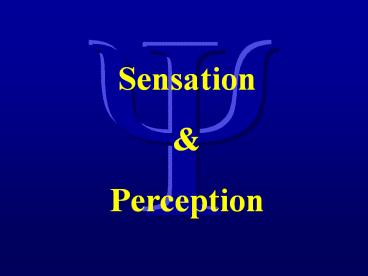PowerPoint-Pr PowerPoint PPT Presentation
1 / 61
Title: PowerPoint-Pr
1
?
Sensation Perception
2
?
Motion Vision I Basic Motion Vision
3
Organization
- How to do well in class
- Some Clarifications on V1
- Motion Vision
4
1. How to do well in class?
5
1. Attend class!
- Class attendance correlates with GPA typically
around 0.3 (Schuman et al., 1985) but can reach
correlations of up to 0.4! (Larrieu, 2004)
6
2. Study! (a lot)
- The effect of studying seems to be highly
nonlinear. It only makes a significant difference
if one studies more than 5 hours per day!
(Schuman et al., 1985).
7
3. Dont drink!
- Effects of alcohol consumption on GPA have been
consistently found to be negative and significant
(Finnell Jones, 1975). The magnitude of the
correlations is in the ballpark of -0.2 (Larrieu,
2004).
8
4. Dont do drugs!
- Effects of Marihuana consumption on GPA have been
found to be significantly negative. The magnitude
of the correlation is in the ballpark of -0.25
(Larrieu, 2004).
9
Summary
- Attend as many classes as possible
- Study at least 5 hours a day (outside of class)
- Dont drink
- Dont do drugs
- ? Revenge of the Nerds.
- Caveat The effects outlined above might be
non-independent and might not be causal.
10
2. Some clarifications on V1
Fourier Decomposition of an Image in V1? But
why? How does this relate to actual images?
11
Fouriers theorem
- EVERY waveform can be decomposed into simple
sine-waves with the right amplitude and
frequency. - EVERY waveform can be synthesized by adding
sine-waves with the right amplitude and frequency.
12
(No Transcript)
13
Picture representation in V1
14
(No Transcript)
15
(No Transcript)
16
3. Motion Vision
17
Why care about Motion?
18
- Most animals have some form of motion vision (vs.
Color)
- A large part of the brain is devoted to motion
processing in these animals
19
Motion processing in the brain
20
Why such an emphasis on motion?
21
Motion as a rich source of survival-relevant
information
- Ecologically relevant information
- Breaks camouflage
- Heading perception, time to collision
- Image segmentation, figure/ground
- Object perception, structure from motion
- Depth perception
- Attention guidance
22
Some demonstrations...
- Structure from motion
- Breaking camouflage
- Depth (Parallax)
23
Structure from Motion
24
Breaking Camouflage
25
Depth perception
26
Motion Displacement in space over time?
27
Color Wavelength?
Monnier Shevell (2003, 2004)
28
Motion as a separate perceptual dimension
- The motion aftereffect (MAE)
Motion Displacement in space over time?
- Apparent motion
- Motion illusions, induced movement
29
Some demonstrations...
30
The motion aftereffect
31
Apparent motion
32
Induced motion
33
How hard can it be?
34
Challenges
- Relation between movement of luminance on retina
and object movement in world is weak.
- Apparent motion, flicker, correspondence problem
- Image segmentation
35
The motion correspondence problem
36
Yet...
37
Basic principles
- Reichardt detectors in V1 integrate luminance
signals from the LGN.
Retina ? LGN ? V1
38
Reichardt detectors
39
Reichardt detectors
- This model allows the extraction of motion
information by nonlinear summation of the
luminance inputs.
- It achieves Direction and Speed selectivity of
the neural response
- It is physiologically plausible.
40
Review Orientation tuning in V1
- V1 neurons have orientation preferences.
- These can be understood by analyzing the
receptive field properties of the respective
cell.
41
Review Orientation tuning in V1
42
Space-time plots
- Motion as orientation/tilt in space-time
43
Motion as a tilt in space-time
- V1 neurons tuned for orientation in space time ?
Extracting motion information by Direction, speed
selectivity.
44
Adding direction to speed
Tilted hot-dog
45
So computationally, motion detection is
essentially the same as edge detection. The RFs
are just oriented in different dimensions.
- How to construct a space-time receptive field?
46
Constructing the Space-Time RF
The space-time RF emerges
47
Single neuron response
48
Single neuron level
n 1
- Can tell what the preference of each is, given we
know what object is moving in which direction.
49
Tuning curves
50
Some demonstrations
- Motion receptive field in single MT neuron
51
(No Transcript)
52
Some demonstrations
- Gaussian direction tuning in single MT neuron
53
(No Transcript)
54
Population response
n many
Direction-Preference of respective neuron in
- Brain wants to know about the properties of
objects in the world, given activation states in
the brain.
- Inference possible if preferences of each neuron
are known by brain (Labeled line)
55
Summary
- Motion perception is very common among animals.
Its evolutionary survival value is high.
- Motion detection is an inference made by the
brain about the dynamics of objects in the world
56
Summary
- The perception of motion is a fundamental
perceptual quality. It is not derived from other
qualities.
- Motion extraction in V1 can be understood by the
concepts of Reichardt detectors and Orientation
tuning in space-time.
57
There is much more...
58
Multi-step model of motion perception
1 Local measurement of motion information
(direction, speed), esp. V1
2 Constrained integration of local motion
information (particularly in MT)
3 Utilizing motion information for action
guidance (e.g. MST, FEF, etc.)
59
Higher upward
- Perception of biological motion
- Perception of structure from motion
- Perception of heading (optic flow), taking eye
movements into account, etc.
60
Motion processing in the brain
61
Thank you!

